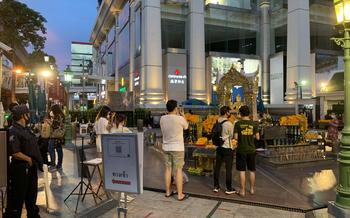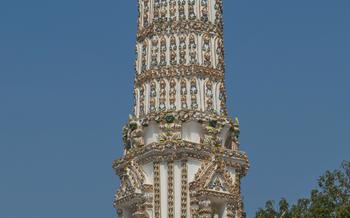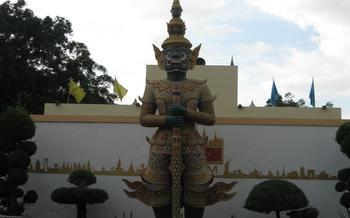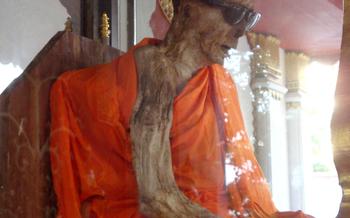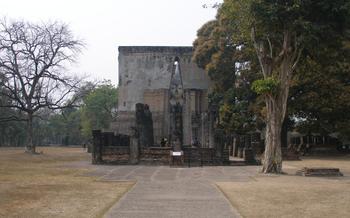
Wat Tham Talu
- Wat Tham Talu: An Overview
- Exploring the Cave
- The Surrounding Landscapes
- Paying Respect and Making Offerings
- Exploring the Temple Grounds
- Tips for Photography Enthusiasts
- Guided Tours and Local Guides
- Accessibility and Getting There
- Nearby Attractions and Activities
- Budget and Cost Considerations
- Accommodation and Where to Stay
- Food and Drink Options
- Insider Tip: Unveiling the Hidden Gems of Wat Tham Talu
Wat Tham Talu: An Overview
Deep in the heart of Thailand's Chumphon province, nestled amidst lush tropical forests and towering limestone cliffs, lies the enigmatic Wat Tham Talu. This sacred temple, with its unique cave setting, is a place of profound spiritual significance and a testament to the artistic and religious heritage of the region.
The history of Wat Tham Talu dates back centuries, with legends and folklore intertwining to create a rich tapestry of its origins. According to local tales, the cave was once inhabited by a revered monk who achieved enlightenment through meditation. His presence is said to have imbued the cave with a sacred aura, attracting devotees and pilgrims seeking spiritual guidance and blessings.
What sets Wat Tham Talu apart from other temples is its remarkable location within a natural cave. The cave's intricate network of chambers and tunnels forms a labyrinthine sanctuary, leading visitors on a journey of discovery and introspection. The temple's unique setting adds an air of mystery and wonder, enhancing the overall spiritual experience.
Practical information for visitors includes the temple's hours of operation, which are daily from 8 am to 5 pm. The entrance fee is a modest 20 baht per person, and a dress code is in place, requiring visitors to dress respectfully, covering their shoulders and knees.
One memorable visit to Wat Tham Talu stands out in my mind. As I entered the cave, the cool air and the echoing sounds of dripping water created an atmosphere of tranquility. The flickering candlelight illuminated the intricate carvings and statues that adorned the cave walls, casting an ethereal glow upon the surroundings. It was a moment of profound peace and serenity, where the worries of the outside world melted away.
Exploring the Cave
Wat Tham Talu's cave is a natural wonder that beckons adventurers and nature enthusiasts alike. As you enter the cave, you'll be greeted by a cool and humid atmosphere, a stark contrast to the tropical heat outside. The cave's layout is intricate, with tunnels and chambers leading in different directions. Each twist and turn reveals a new spectacle of stalactites and stalagmites, some resembling mythical creatures, others abstract art installations.
Venture deeper into the cave, and you'll encounter a series of Buddha images enshrined within the rock formations. Some are small and delicate, while others are colossal, exuding an aura of serenity and devotion. The cave's acoustics create a unique soundscape, where the dripping of water and the echo of footsteps add to the mystical ambiance.
Navigating the cave requires a sense of adventure and caution. The paths can be slippery, and some sections involve climbing over rocks and squeezing through narrow passages. It's advisable to wear sturdy shoes and bring a flashlight or headlamp to illuminate the darker corners.
During my exploration, I had an unexpected encounter that left a lasting impression. As I rounded a corner, I stumbled upon a group of bats hanging from the ceiling. Startled, they took flight, filling the air with a flurry of wings and high-pitched squeaks. The moment was both thrilling and awe-inspiring, a reminder of the diverse wildlife that calls this cave home.
The Surrounding Landscapes
The scenic beauty surrounding Wat Tham Talu is an integral part of its charm. Nestled amidst verdant forests, the temple exudes an aura of serenity and tranquility. The lush greenery provides a stunning backdrop for the temple and creates a harmonious blend of nature and spirituality.
As you explore the temple grounds, take a moment to appreciate the panoramic views from various vantage points. The rolling hills and dense forests offer a feast for the eyes. Capture the beauty of the surrounding landscapes with your camera and create lasting memories of your visit.
Keep an eye out for the diverse wildlife that calls this area home. Observe colorful birds flitting among the trees or spot playful squirrels scampering across the path. The temple's serene environment provides a sanctuary for these creatures, allowing visitors to witness the wonders of nature firsthand.
One particular encounter with wildlife during my visit stands out vividly in my mind. As I was exploring the forest trails, I stumbled upon a family of wild monkeys swinging through the trees. Their playful antics and curious gazes created a magical moment that reminded me of the interconnectedness of all living beings.
Paying Respect and Making Offerings
Visiting Wat Tham Talu involves immersing oneself in Thai culture and traditions, including paying proper respect to the Buddha statues and making offerings. It's essential to approach the temple with humility and an understanding of the significance of these rituals.
Offerings are a way of expressing gratitude and seeking blessings from the Buddha. Common offerings include lotus flowers, candles, incense sticks, and gold leaf sheets. Visitors can purchase these offerings from vendors near the temple entrance.
To make an offering, approach the Buddha statues with reverence. Kneel on the mat in front of the statue, light a candle or incense stick, and place it in the designated holder. Then, take a gold leaf sheet and gently press it onto the statue's surface, symbolizing the act of gilding and paying respect.
One memorable interaction I had with a local while making offerings stands out. As I was placing a lotus flower in front of a Buddha statue, an elderly woman approached me and smiled. She gestured for me to follow her and led me to a nearby monk. The monk blessed the offerings and gave me a small amulet as a token of appreciation. It was a heartwarming moment that deepened my understanding of the significance of these rituals in Thai culture.
Exploring the Temple Grounds
Beyond the cave, Wat Tham Talu offers an array of other structures and features that showcase its rich cultural and religious heritage. As you wander through the temple grounds, you'll encounter stupas, chedis, and other religious monuments that hold deep significance in Thai Buddhism. These structures are adorned with intricate carvings, colorful tiles, and shimmering spires, creating a visually stunning and sacred atmosphere.
The stupas, or bell-shaped structures, symbolize the Buddha's teachings and represent the path to enlightenment. The chedis, on the other hand, are tall, spire-shaped structures that enshrine relics or sacred objects. These monuments serve as reminders of the Buddha's life and teachings, inspiring visitors to reflect on their own spiritual journey.
In addition to these religious structures, the temple grounds also feature a number of buildings and facilities that cater to the needs of visitors. There are rest areas where you can take a break and soak in the tranquil ambiance, as well as a meditation hall where you can find a quiet space for contemplation. The temple also houses a museum that showcases artifacts and relics related to the history of the temple and the surrounding region.
As you explore the temple grounds, be sure to take time to appreciate the intricate details and symbolism embedded in each structure. The architecture, sculptures, and murals tell a story of faith, devotion, and the enduring legacy of Thai Buddhism.
Anecdote:
During my visit to Wat Tham Talu, I had a chance encounter with a monk who was tending to the temple grounds. He kindly invited me to join him for a cup of tea and shared stories about the history of the temple and its significance to the local community. As we sat together, surrounded by the serene beauty of the temple grounds, I couldn't help but feel a deep sense of peace and connection to the spiritual essence of this sacred place.
Tips for Photography Enthusiasts
Wat Tham Talu presents a photographer's paradise with its captivating cave formations, intricate Buddha statues, and serene landscapes. To capture the temple's beauty optimally, plan your visit during the golden hours of sunrise or sunset when the natural light illuminates the cave's interior, casting a warm glow on the stalactites and stalagmites.
For cave photography, a tripod is essential for stabilizing your camera and minimizing blur caused by camera shake. Experiment with different shutter speeds to capture the movement of water droplets or create a sense of motion in the flowing stalactites. Use a wide-angle lens to capture the vastness of the cave and highlight its impressive scale.
Compose your shots creatively by using leading lines, such as the cave's natural pathways or the cascading stalactites, to draw the viewer's eye into the image. Look for unique angles and perspectives, such as shooting from a low angle to emphasize the height of the cave's ceiling or capturing reflections in the water pools.
During my visit, I stumbled upon a hidden chamber adorned with shimmering crystals that reflected the light, creating a magical atmosphere. I spent hours experimenting with different compositions and settings, resulting in some of the most stunning cave photographs I've ever taken.
Guided Tours and Local Guides
For a more in-depth and enriching experience, consider booking a guided tour of Wat Tham Talu. Knowledgeable guides can provide historical context, explain the significance of the Buddha statues, and point out hidden details and features that you might miss on your own.
To find a reputable tour guide, inquire at your hotel or hostel, or search online for recommended tour operators. Make sure to read reviews and compare prices before making a booking.
During the tour, your guide will lead you through the cave, explaining the geological formations and pointing out the various Buddha images. They will also share stories and legends associated with the temple, bringing its history and significance to life.
I had the pleasure of taking a guided tour with a local guide named Somchai. He was incredibly knowledgeable and passionate about the temple. He shared fascinating stories about the history of the cave and the Buddha statues, and even taught me some basic Thai phrases. Thanks to Somchai, my visit to Wat Tham Talu was truly unforgettable.
Accessibility and Getting There
Wat Tham Talu is situated in the Tha Sae district, nestled within the lush greenery of Chumphon province. Its secluded location adds to its charm, making it an off-the-beaten-track gem waiting to be discovered. The temple is approximately 35 kilometers from the city center and can be reached by various means of transportation.
For those arriving by public transport, regular buses depart from Chumphon's main bus station to Tha Sae town. From there, a short songthaew ride or taxi can take you directly to the temple. The journey by bus and songthaew combined takes about an hour and costs around 100 baht.
If you prefer the convenience of a private vehicle, renting a car or hiring a taxi is a great option. The drive from Chumphon city to Wat Tham Talu takes about 45 minutes, offering a scenic journey through the province's tranquil countryside. Rental cars can be hired from various agencies in Chumphon, with prices starting from around 1,000 baht per day.
Once you reach Tha Sae town, follow the signs leading to Wat Tham Talu. The temple is well-marked, and the locals are always happy to provide directions if needed. Embrace the adventure and enjoy the journey as you make your way to this hidden gem.
Nearby Attractions and Activities
Wat Tham Talu is surrounded by a wealth of natural and cultural attractions, making it an ideal base for exploring the region. A short drive away, visitors can immerse themselves in the pristine beauty of Khao Chong Krajok National Park, home to cascading waterfalls, lush rainforests, and diverse wildlife. For those seeking a more leisurely experience, the nearby Pak Nam Chumphon Beach offers a tranquil retreat, with its pristine sands and crystal-clear waters inviting visitors to relax and soak up the sun.
History buffs can delve into the region's rich past at the Chumphon National Museum, which houses a fascinating collection of artifacts and exhibits showcasing the province's cultural heritage. For a unique glimpse into local life, visitors can explore the vibrant Chumphon Night Market, where they can sample delicious street food, browse local handicrafts, and experience the infectious energy of this bustling market.
Combining a visit to Wat Tham Talu with these nearby attractions allows travelers to create a well-rounded itinerary that caters to diverse interests. Whether seeking adventure, relaxation, or cultural immersion, the Chumphon region offers an array of experiences to create a memorable and fulfilling trip.
Anecdote:
During my visit to Wat Tham Talu, I stumbled upon a hidden gem nestled within the temple complex. As I explored the grounds, I discovered a secluded meditation cave adorned with intricate carvings and serene Buddha images. The atmosphere was incredibly peaceful and conducive to reflection. I spent several moments in quiet contemplation, finding solace and tranquility within this sacred space.
Budget and Cost Considerations
Visiting Wat Tham Talu is a relatively affordable experience. Transportation costs will depend on your starting point and chosen mode of transport. From Chumphon town, you can take a local bus or songthaew for around 50-100 THB. Renting a motorbike or bicycle is another option, providing flexibility and allowing you to explore the surrounding area at your own pace.
Admission to the temple is free, but donations are welcome. You might consider leaving a small offering at the Buddha statues or contributing to the temple's upkeep. If you opt for a guided tour, prices typically range from 200-500 THB, depending on the group size and duration.
Food and drinks are available at the temple, with simple meals and snacks starting from 50 THB. There are also several local restaurants and cafes nearby where you can enjoy a wider range of options.
Overall, you can expect to spend around 200-500 THB for a day trip to Wat Tham Talu, including transportation, food, and optional activities. Budget-conscious travelers can save money by opting for local transportation, packing their own snacks, and visiting during the off-season.
Accommodation and Where to Stay
When planning your visit to Wat Tham Talu, consider staying in the nearby town of Chumphon to make the most of your time in the area. Chumphon offers a range of accommodation options to suit every budget and preference. For a truly immersive experience, opt for a traditional Thai-style guesthouse or homestay, where you can interact with local families and learn about their way of life.
For those seeking comfort and convenience, there are several hotels and resorts in Chumphon that offer modern amenities and facilities. Whether you prefer a beachfront property, a cozy boutique hotel, or a family-friendly resort, you'll find plenty of options to choose from.
To ensure a hassle-free stay, book your accommodation in advance, especially during peak tourist seasons. Consider factors such as proximity to the temple, amenities, and your budget when making your choice. With a variety of options available, you're sure to find the perfect place to rest and recharge after a day of exploring Wat Tham Talu and its surroundings.
Food and Drink Options
The culinary scene around Wat Tham Talu offers a tantalizing array of local flavors and specialties. Visitors can indulge in authentic Thai cuisine at nearby restaurants, ranging from humble eateries to charming cafes. Must-try dishes include the aromatic Phanaeng curry, a rich red curry with a hint of sweetness, and the spicy Tom Yum soup, a fragrant broth brimming with shrimp, mushrooms, and lemongrass.
For a quick bite, savor the crispy delights of fried bananas or indulge in the sweet and tangy flavors of fresh mango sticky rice, a classic Thai dessert. Vegetarian and vegan options are readily available, ensuring that everyone can relish the local cuisine.
In keeping with the serene atmosphere of the temple, there are no alcohol vendors within the temple grounds. However, visitors can unwind with a refreshing coconut drink or a cup of aromatic Thai tea, relishing the tranquility of the surroundings.
Insider Tip: Unveiling the Hidden Gems of Wat Tham Talu
Beyond the main attractions of Wat Tham Talu, there are hidden treasures waiting to be discovered by curious explorers. One such secret spot is a secluded meditation cave tucked away amidst the lush greenery. This serene sanctuary offers a tranquil ambiance for reflection and spiritual connection. To find it, venture off the beaten path and follow a narrow trail that leads to the cave entrance. Inside, you'll be greeted by a serene atmosphere and the gentle sound of dripping water. Take a moment to sit in silence and let the tranquility envelop you, allowing your mind to find inner peace.
Another insider tip is to visit the temple during the early morning hours or late afternoon when the crowds are fewer. This will allow you to fully immerse yourself in the temple's sacred atmosphere and capture stunning photographs without distractions. The golden rays of the rising or setting sun cast a magical glow on the temple grounds, creating a picturesque scene that will leave you in awe. Embrace the tranquility of the surroundings and let the beauty of Wat Tham Talu captivate your senses.
